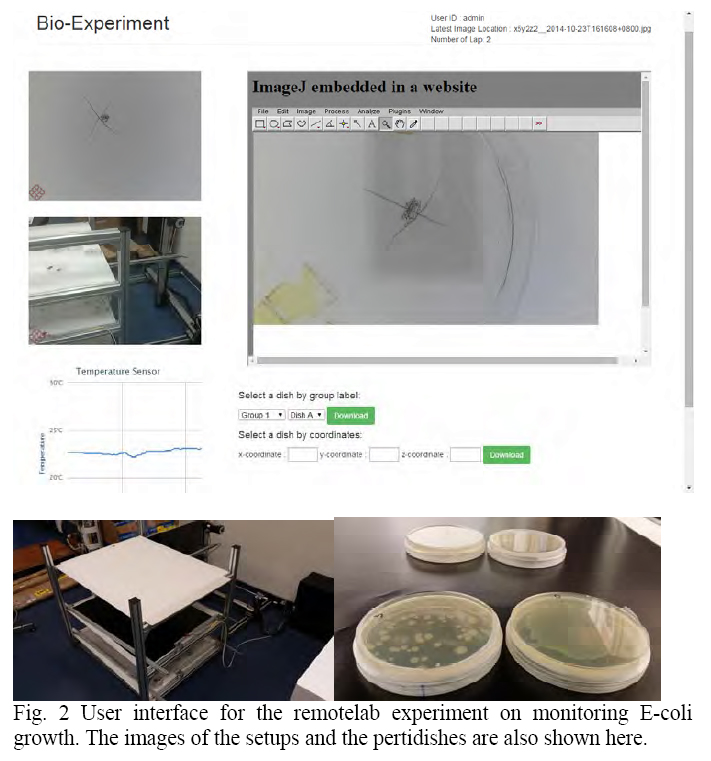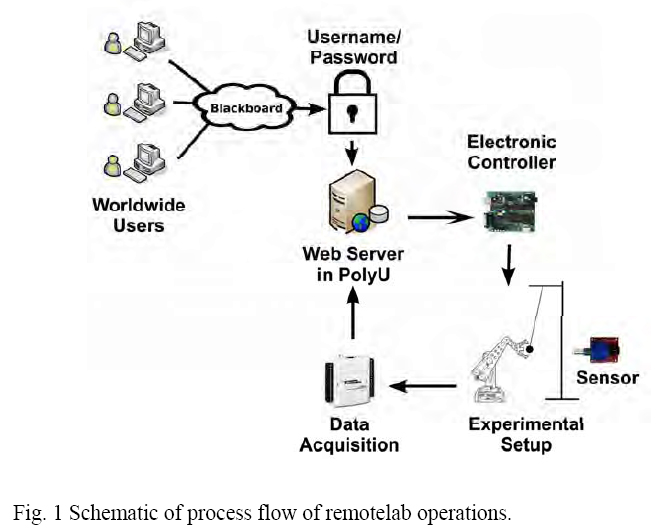
|
![]() : Complementary Laboratory Experience for Science Service Teaching via Remote Accessible Experiments
: Complementary Laboratory Experience for Science Service Teaching via Remote Accessible Experiments
Description
An integral component of science learning is the performance of experiments; after all, the foundation of scientific knowledge is heavily reliant on the discoveries through experimentations. Laboratory learning therefore offers a more authentic picture of the scientific phenomena, enhancing students' understanding of the principles as in the real-life situations. However, most of the level-one science service-teaching subjects in PolyU are conducted through lecture/tutorial modes, due to the large classes and the lack of laboratory spaces/ equipment.
AP has previously devised a platform for various remote-controlled experiemnts for 1-st year undergraduates (under 3-year curriculum). Based on previous experiences, we constructed a scaled-up version of the platform that covered also chemistry and biology experiments. The user-interface was incorporated into Blackboard to facilitate the teaching and learning process. The project targeted at exploring the opportunity to conduct remote experiments in various science disciplines other than physics.
The remotelab platform consists of a server which hosts a number of experiments and the booking information. Students of specific subjects were registered to the platform with their student number, and they simply have to login via Blackboard to get access to the platform (no password information was retrieved by the platform). Each experiment setup is independently controlled by a computer, which is responsible for passing the remote control signals to the setup for changing the experiment parameters, and also retrieves and transmits results to the users for further analysis. A schematic of the process flow is shown in Fig. 1.
A total of three experiments were implemented in this project, and the details of piloting such setups are described as follows.
(i) Interference of light
A pilot was conducted for this experiment in the subject AP10001 (Introduction to Physics, class size ~ 100) during Sem 2 of 2013/14 as a group assignment. A short briefing session was first conducted in the lecture, and students were instructed to finish the experiment in groups of 4. The response of students over the experiment was fairly positive, with over half of the students agreeing that they have mastered a better understanding on the topic of wave interference effect. Comments were collected from a postexperiment survey. Generally students agreed on the novelty of the idea of remote experiments, and that the practice provided great flexibility on their learning schedules. Suggestions concerning the technical improvements of the setup were collected.
An attempt was made to compare the understanding on the topic of interference by students enrolled in different semesters in 2013/14, noting that the remote experiment was pilot run in Sem2. Based on two similar, compulsory questions on interference, the marks attained by two batches of students enrolled to the same subject (AP10001, class sizes = 187 (Sem 1) and 120 (Sem2)) in two semesters in 2013/14 were compared. The percentage of scores obtained by the students raised from 32% to 50%. We note with caution the positive impact of remotelab on student learning, and more trial runs and data have to be collected for more conclusive comments on the influence of remotelab on students' science learning.
(ii) Monitoring of E-coli growth
An x-y-z automatic imaging system was constructed for monitoring the growth of E-coil in a constant-temperature environment over a prolonged duration (1 week). The petri dishes were prepared by students during the class, and were then stored in a room with constant temperature and humidity. Images of individual discs were taken at regular time intervals, and students perform subsequent image analysis after one week by selecting the images of the culture discs they prepared. Open-source image analysis tools (ImageJ) were provided on the Blackboard for simple and automatic image analysis, and a briefing session was conducted to introduce the software to the students. The nature of the experiment precluded any user manipulation of the setups when it was run; nevertheless, a page was established to allow students to view the setup to make this an 'authentic' laboratory experience for students (Fig. 2).

- The participation of the students was not satisfactory. Given the briefing session was conducted at 8:30 am, there were only a few students attending the class. And apparently students were not capable to comprehend the image analysis software even with in-class instructions and online tutorials. Eventually students were asked only to collect the final image of their disc after 1 week for counting the colonies manually.
- Students were of diversified background for this subject (it was a CAR subject with no pre-requisite), and the analysis technique proved too complicated for the students.
- The nature of remote experiments naturally implies the lack of instructors to provide immediate technical support. Given such a situation, thorough preparations have to be made by the project team, instructors and the students. Detailed documentations on FAQ and debugging have to be done. For teachers, careful preparation of instructions and briefing sessions (either in lessons or in form of videos) are needed to get students prepared for the experiment. Finally, students should also be reminded about careful preparations to perform the experiment and, if time permits, repeat the work (which is generally impossible in conventional lab arrangements).
- The current (and conventional) way of experiment, while effective in terms of fortifying students' learning in lectures, is not really an intellectually stimulating experience. Students can be encouraged to 'explore' the science through their own investigations, by designing their own experiments (after given sufficient instructions on controlling the setup). Such kind of 'flipped laboratory' experience (where students discover the principles instead of verifying the learnt theories) fits well with the remotelab platform, at which students learn can explore at their own pace.
- The project team is fully aware of the shortcomings of the remotelab in various scenarios, through discussion with colleagues of different disciplines. We are also assertive of the positive educational influence of authentic experiments and simulations in assisting student learning. The remotelab should be best when used as one of the teaching modes for assisting the learning and teaching processes, and should be adopted at places which best illustrates its advantages (e.g. prolonged experiments, reducing the risks on unskilled personnel, etc.).
Disclaimer
The experiences reported in this section are collected from the project leaders. EDC is not liable for the accuracy of information and possible infringements of copyright associated with individual cases.
